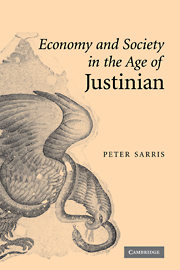Book contents
- Frontmatter
- Contents
- List of figures
- Preface
- Introduction
- 1 Egypt and the political economy of empire
- 2 The Apion archive: economic structure and estate accounts
- 3 Labour and administration: the evidence of the contractual papyri
- 4 Letters and petitions: social relations in the sixth-century Oxyrhynchite
- 5 The Apiones and their analogues
- 6 On the margins of magnate power: Dioscorus and Aphrodito
- 7 Landscapes of power: the great estate beyond Egypt
- 8 The historiography of the great estate
- 9 The great estate and the imperial authorities
- 10 The rise of the great estate
- 11 Economy and society in the age of Justinian
- Conclusion
- Bibliography
- Index
9 - The great estate and the imperial authorities
Published online by Cambridge University Press: 24 July 2009
- Frontmatter
- Contents
- List of figures
- Preface
- Introduction
- 1 Egypt and the political economy of empire
- 2 The Apion archive: economic structure and estate accounts
- 3 Labour and administration: the evidence of the contractual papyri
- 4 Letters and petitions: social relations in the sixth-century Oxyrhynchite
- 5 The Apiones and their analogues
- 6 On the margins of magnate power: Dioscorus and Aphrodito
- 7 Landscapes of power: the great estate beyond Egypt
- 8 The historiography of the great estate
- 9 The great estate and the imperial authorities
- 10 The rise of the great estate
- 11 Economy and society in the age of Justinian
- Conclusion
- Bibliography
- Index
Summary
INTRODUCTION
The question of the nature of the relationship between the great estates and the imperial authorities is central to any understanding of the political economy of the East Roman Empire in the sixth century. As seen in the Introduction, our contemporary legal sources, such as the constitutions issued by the Emperor Justinian, give the impression of a conflictual relationship, whereby public authority was being progressively undermined by the private economic and social influence of aristocratic landowners. The same conflictual model is in turn reflected back at the imperial government through the critiques of Procopius, John Lydus, and other sixth-century authors of an essentially conservative frame of mind. In recent years, however, historians have become increasingly inclined to emphasise co-operation between public and private authority, aristocrat and emperor. At its most extreme, this tendency has led some to argue that the great estates of late antiquity were essentially the product of imperial fiat. They were the outcome of a deliberate policy whereby landowners were burdened with heavy duties and responsibilities, such as the collection of taxes or the maintenance of imperial troops, which may not necessarily have even served their interests. They were, as Gascou has put it, ‘public law institutions’ or ‘a development of the public economy’. As in so many other areas of history, concentration has shifted from diachronic analysis emphasising conflict to synchronic analysis emphasising stability.
But how useful has this change of emphasis been? To what extent is revisionism itself now in need of revision?
- Type
- Chapter
- Information
- Economy and Society in the Age of Justinian , pp. 149 - 176Publisher: Cambridge University PressPrint publication year: 2006
- 1
- Cited by

